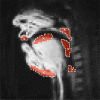Dark tone quality and vocal tract shaping in soprano song production: Insights from real-time MRI
- PMID: 34291230
- PMCID: PMC8273971
- DOI: 10.1121/10.0005109
Dark tone quality and vocal tract shaping in soprano song production: Insights from real-time MRI
Abstract
Tone quality termed "dark" is an aesthetically important property of Western classical voice performance and has been associated with lowered formant frequencies, lowered larynx, and widened pharynx. The present study uses real-time magnetic resonance imaging with synchronous audio recordings to investigate dark tone quality in four professionally trained sopranos with enhanced ecological validity and a relatively complete view of the vocal tract. Findings differ from traditional accounts, indicating that labial narrowing may be the primary driver of dark tone quality across performers, while many other aspects of vocal tract shaping are shown to differ significantly in a performer-specific way.
© 2021 Author(s).
Figures




Similar articles
-
Articulation and vocal tract acoustics at soprano subject's high fundamental frequencies.J Acoust Soc Am. 2015 May;137(5):2586-95. doi: 10.1121/1.4919356. J Acoust Soc Am. 2015. PMID: 25994691
-
On Short-Time Estimation of Vocal Tract Length from Formant Frequencies.PLoS One. 2015 Jul 15;10(7):e0132193. doi: 10.1371/journal.pone.0132193. eCollection 2015. PLoS One. 2015. PMID: 26177102 Free PMC article.
-
Determining the Relevant Criteria for Three-dimensional Vocal Tract Characterization.J Voice. 2018 Mar;32(2):130-142. doi: 10.1016/j.jvoice.2017.04.001. Epub 2017 Jun 21. J Voice. 2018. PMID: 28647430
-
Interactive Augmentation of Voice Quality and Reduction of Breath Airflow in the Soprano Voice.J Voice. 2016 Nov;30(6):760.e15-760.e21. doi: 10.1016/j.jvoice.2015.09.016. Epub 2015 Nov 10. J Voice. 2016. PMID: 26564580 Review.
-
Acoustics of the trained versus untrained singing voice.Curr Opin Otolaryngol Head Neck Surg. 2009 Jun;17(3):155-9. doi: 10.1097/MOO.0b013e32832af11b. Curr Opin Otolaryngol Head Neck Surg. 2009. PMID: 19365264 Review.
Cited by
-
An open-source toolbox for measuring vocal tract shape from real-time magnetic resonance images.Behav Res Methods. 2024 Mar;56(3):2623-2635. doi: 10.3758/s13428-023-02171-9. Epub 2023 Jul 28. Behav Res Methods. 2024. PMID: 37507650 Free PMC article.
References
-
- Boersma, P. (2001). “ Praat: A system for doing phonetics by computer,” Glot. Int. 5, 341–345.
LinkOut - more resources
Full Text Sources

